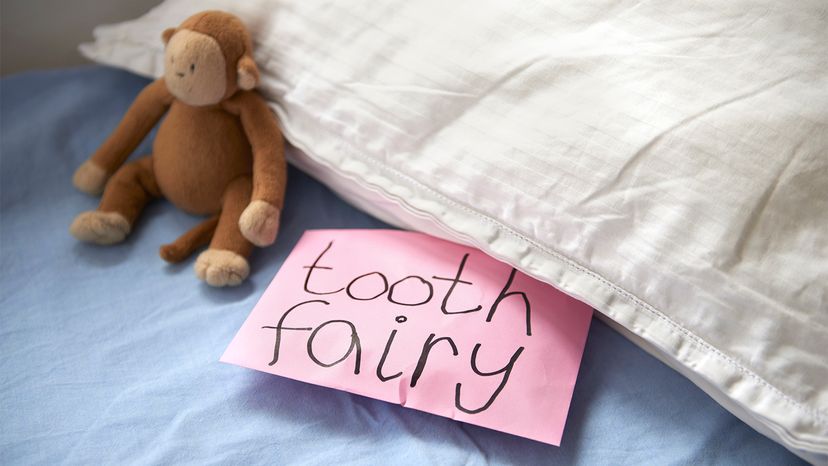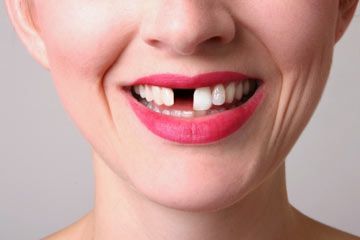
As an anthropologist and science writer with a background in archaeology, Kristina Killgrove is used to dealing with teeth and bones. But even she wasn't prepared for the sight of her 7-year-old daughter extracting her own upper right central incisor in an effort to cash it in. "I was initially inspired to track down the source of the tooth fairy legend when my older daughter lost her first tooth," Killgrove, who explored the legend in a 2016 piece for "Forbes," says by email. "She knew the tooth fairy was not real, but wanted to know when and why the story began."
Even if you aren't familiar with the tooth fairy's origin story, you've likely heard of her or encountered a kid like Killgrove's daughter who's perhaps a little overly excited to earn some dough. The folklore dictates that when a child loses a baby tooth, they should place it under their pillow at night and when they awake the next morning, they'll find their lost tooth has been replaced with a small amount of money, courtesy of a magical, seemingly enamel-obsessed sprite.
Advertisement
Unlike Santa Claus and the Easter Bunny, the tooth fairy has a somewhat enigmatic history. "I was surprised that the tooth fairy is a comparatively new legend," Killgrove says. "She started to take off with the boomer generation getting paid for their teeth, and was cemented in encyclopedias and the media with Gen X." And while other childhood characters typically have roots in religious traditions, Killgrove says "the secular tooth fairy is really a modern invention!"
So, who is this mysterious mythical creature and why is she so dead set on swapping baby teeth for cash? "Some have suggested that the story of the tooth fairy dates back to Norse traditions from the 13th century, when it became a tradition for a 'tooth fee' to be given to a child when they lost their first baby tooth," says Dr. Sal Colombo, DMD, of The Little Royals Dentistry for Kids in Jupiter, Florida, in an email interview. "The more modern tooth fairy as we know it was first referenced in an editorial from the Chicago Daily Tribune in 1908, which at that time valued the tooth fairy's contribution at 5 cents [compared to an average approaching $4 a tooth today]."
While Killgrove pegs the popularity of the tooth fairy to the childhood of the boomers and Colombo dates the character's birth back to the 1200s, writer and publisher Michael Hingston explained in his 2014 piece for Salon, that the legend really took off in the 1970s when a woman named Rosemary Wells took it upon herself to thoroughly research and report on the tooth fairy's saga.
"Dr. Wells was a professor teaching scientific writing at Northwestern University's dental school in the 1970s, when she realized there was little information about the origin of the tooth fairy legend," Killgrove says. "She worked on tracking down the origin and surveyed Americans on their tooth fairy practices for 20 years, before starting a small museum in her home dedicated to the tooth fairy. I came across her work as well as Tad Tuleja's in searching for the tooth fairy in the field of folklore studies."
"I love when people accidentally become world experts on something, and Rosemary Wells is a great example of this," Hingston said. "She asked a simple question, followed her curiosity, and ended up with a private museum in her home dedicated to the tooth fairy. How do you not root for that?"
As Hingston writes, the tooth fairy is a relatively recent creation but "rituals surrounding tooth loss date back much further than that." He points out that every single recorded human culture has some sort of traditional practice centered around the disposal of lost baby teeth, and researcher B. R. Townend broke down the various rituals in "The Non-therapeutic Extraction of Teeth and Its Relation to the Ritual Disposal of Shed Deciduous Teeth" in the British Dental Journal in 1963. As described in "The Tales Teeth Tell" by Tanya M. Smith, Townend said that cultures tend to do one of nine things: throw the tooth into the sun, into fire, between the legs, onto or over the roof of the house, place it in a mouse hole, bury it, hide it, place it in a tree or on a wall, or have the mother, child or an animal swallow it.
Americans, however, spun the legend in a unique way, blending and augmenting existing traditions to result in a benevolent fairy who rewards the dental milestone with money. And as Hingston points out, the tooth fairy's star rose at a time when Disney was introducing kind and cuddly characters that are perfectly in line with the tooth fairy's sweet and supernatural image.
Advertisement

